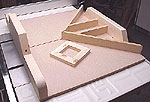The perfect mitre. You know, the kind that are machine made. The kind you see on picture frames. I want mitres that are tight, elegant. While I realize nobody can tell me what my problem is. Ok, maybe you can, but what I am looking for are tips, tricks, techniques to accomplishing this elusive task.
Here is what I have tried. I have set both my table saw mitre gague and my mitre saw that I am pretty sure cut on an accurate 45 angle. ( I say pretty sure, cause if it does in fact cut an accurate 45, the mitres should all fall into line when I make the frame ). I am thinking it may be my assembly method. Heck, I don't know. My problem is, that when I go to put the frame together, I nearly always have "gaps" in the joint. Usually on opposite ends of my frame, mostly on the outside edge. How do I fix this? It's definately possible that I have 2 machines that don't cut perfect 45s. I make sure that the 4 sides of the frame are of equal length, thickness, and width.
What do you people do to get nice tight mitres? Got anything to share?
Here is what I have tried. I have set both my table saw mitre gague and my mitre saw that I am pretty sure cut on an accurate 45 angle. ( I say pretty sure, cause if it does in fact cut an accurate 45, the mitres should all fall into line when I make the frame ). I am thinking it may be my assembly method. Heck, I don't know. My problem is, that when I go to put the frame together, I nearly always have "gaps" in the joint. Usually on opposite ends of my frame, mostly on the outside edge. How do I fix this? It's definately possible that I have 2 machines that don't cut perfect 45s. I make sure that the 4 sides of the frame are of equal length, thickness, and width.
What do you people do to get nice tight mitres? Got anything to share?


